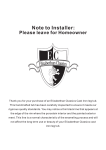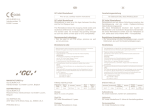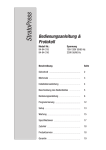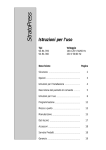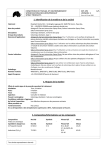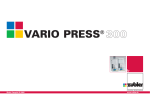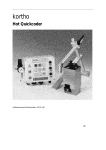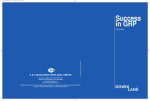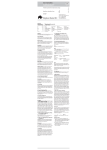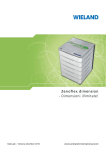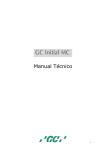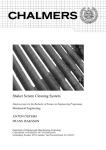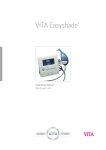Download Antagon Interaction
Transcript
ANTAGON interaction User instructions E l e p h a n t D e n t a l ’s m i s s i o n s t a t e m e n t . Our aim is to make a positive contribution to the society through the development, manufacture and distribution of innovative, high quality product systems that are guaranteed to facilitate the work of dental professionals and increase patient satisfaction. Indication: Elephant Antagon Interaction is the normally expanding, high melting dental ceramic for traditional alloys. Antagon Interaction can be easliy fired on sub-structures with a thermal expansion coefficient between 13.8 and 14.9 µm/m.K (25-500ºC). Contraindication: If patients are known to be allergic to any of the components, the material should not be applied. dental health products 2 Controlled interaction. Antagon Interaction is the new normally expanding, high-melting generation of controlled-interactivity ceramics for traditional alloys. With this ceramic, it is possible to prepare a restauration which exhibits precise control over the light and colour characteristics once it has been placed in the patient’s mouth. The layering structure developed during buildup creates a natural interaction of opalescence and fluorescence. With this intelligent type of ceramic, the restoration reflects every incidence of light as naturally as a normal tooth would. TA B L E O F C O N T E N T S . Control and precision. Colour determination Layer organiser instructions Information regarding underlying copings Paste opaque Opaque dentin Dentin Action-i dentin & x-tra incisal Incisal X-tra i bright, medium & dark Correction & glaze Standard layering structure for Underlying metal copings Individual layering structure Firing and layering structure Guidelines for the use of ceramic furnaces The layering structure is created in the usual way. The dental technician can exercise precise control over the restoration’s layers, ensuring that the result meets all requirements. The highly pragmatic and simple organisation of the harmonised system of colours and powders is reflected in all the components of our product range, the ceramic powders (jar labels), the layer organiser and the layering instructions. The interaction of fluorescence, opalescence, colour and light yields natural aesthetics. With its functional, layered structure, Antagon Interaction has a natural look. Consequently, all layers, whether deep in the restoration or close to the roots are fluorescent, while the remaining layers are predominantly transparent and opalescent. This functional division of properties – where properties are geared to one another precisely – makes this patented system unique and gives rise to the interplay (interaction) that occurs automatically in normal structures. As a result, crowns have a completely natural appearance. 3 PA G E 4 5 6 7 8 9 10 11 12 13 14 15 16 17 Colour determination and Antagon Interaction shadeguides. Antagon Interaction is 100% compatible with Lumin® vacuüm/Vitapan® classical. However, it is vital that technicians working on the restoration use the same reference material and communicate clearly with one another. The Antagon Interaction shadeguides’ pellets are made of the original ceramic, which enable simple and accurate colour determination opaque dentin shadeguide Accurate colours. The Antagon Interaction system employs colour information in a consistent manner. The colour of the completed restoration matches the tooth’s natural colour. Powder combinations can easily be determined using the layer organiser. dentin shadeguide Instr uctions for optimal colour determination. Ask yourself the following questions from time to time: • Am I determining the colour under consistent light conditions? • Is my perception affected by the environment (e.g. sharp colour contrasts)? • Am I using the right shadeguide? • Am I examining the patient’s mouth under the optimal 45° angle? incisal shadeguide 4 Shadeguide of original ceramic Layer Organiser Indication of the powders to be used Indication of the x-tra incisals that may be used T h e l a y e r o r g a n i s e r. Slide open and read. Individual wishes are easily met. The layer organiser is a practical and easy-to-use tool to determine which powders are needed to create the intended colour. From bottom to top – paste opaque to incisal –, the powders associated with the colours involved can be determined accurately. If you slide open the large lower part of the layer organiser, you can read, in logical order, which colour combinations are required to create the layer structure displayed. When applying the incisals or colour corrections between the first and second dentin firing, the colour can be lightened or darkened using x-tra i bright, x-tra i medium or x-tra i dark. The upper part of the layer organiser shows the options for specific colours. During the final construction phase of the layered structure, the incisal third section of the element can be adjusted to the patient’s wishes. The x-tra incisals are all opalescent and yield a natural result due to their interaction with the underlying layers. paste opaque A1 A2 A3 A3,5 A4 B1 B2 B3 B4 C1 C2 C3 C4 D2 D3 D4 opaque dentin A1 A2 A3 A3,5 A4 B1 B2 B3 B4 C1 C2 C3 C4 D2 D3 D4 dentin A1 A2 A3 A3,5 A4 B1 B2 B3 B4 C1 C2 C3 C4 D2 D3 D4 action-i dentin 1A2 3A4 1B2 3B4 1C2 3C4 1A2 1B2 1C2 x-tra incisal x-tra i blue/x-tra i red/x-tra i grey/x-tra i orange/x-tra i clear x-tra i bright/x-tra i medium/x-tra i dark incisal 58 5 59 60 57 59 60 59 60 59 Elephant alloys Biogold Plus, high gold content Orion WX: reduced gold content Antagon Interaction, the ceramic for traditional alloys. Biogold Plus, yellow gold enameling alloy with a high gold content. Orion WX g o l d - r e d u c e d e n a m e l i n g a l l o y. Antagon Interaction can be easily fired on enameling alloys with a thermal expansion coefficient between 13.8 and 14.9 µm/m.K (25-500°C). Only the time needed for cooling may vary: Observe the following instructions when preparing an underlying shell with Biogold Plus: Observe the following instructions when preparing an underlying shell with Orion WX: • Oxydation: 5 min. at a temperature of 950°C without vacuum. Rapid cooling (0 min.) of alloys with a thermal expansion coefficient up to 14.0 µm/m.K (25-500°C). Normal cooling (2 min.) of alloys with a thermal expansion coefficient up to 14.3 µm/m.K (25-500°C). Slow cooling (5-7 min.) of alloys with a thermal expansion coefficient from 14.4 µm/m.K (25-500°C). In view of the special processing methods, observe the user instructions provided by the alloy’s supplier. Crucial information regarding the most commonly used Elephant Dental alloys is included below. Elephant offers a wide range of alloys. Antagon Interaction is highly suitable for use with the following Elephant alloys: For more detailed information, please ask for our alloy chart. • Oxydation: 3 minutes at a temperature of 950°C without vacuum. • Oxide reduction: sandblast the preparation with 125µm aluminium oxide at a maximum pressure of 2 bar or submerge and clean the material in a clean pickling solution for a maximum of 1 minute. • Orion WX: Cool down rapidly after each firing (0 min.). • Cool down normally after each firing (2 minutes). (Or, if this is impossible, cool down slowly for 5 minutes) Alloy Orion UX Orion WX Orion Vesta Bermudent H Orion UX Plus Orion UWX Orion GX Orion Isis Plus Biogold Plus Bermudent Y Biogold AN BioGold Interaction BioGold Pure Orion E Orion Argos TCE (25-500°C) 13,8 13,8 13,8 14,0 14,1 14,1 14,1 14,2 14,3 14,3 14,3 14,3 15,0 14,4 14,7 * Or, if this is impossible, quickly 6 1 Cooling Down with Antagon Interaction Quick (0 min.) Quick (0 min.) Quick (0 min.) Quick (0 min.) Normal (2 min.)* Normal (2 min.)* Normal (2 min.)* Normal (2 min.)* Normal (2 min.)# Normal (2 min.)# Normal (2 min.)# Normal (2 min.)# 1 Normal (4 min.) Slow (5 min.) Slow (7 min.) # Or, if this is impossible, slowly Despite the high TCE value, cool down normally because of its special composition. Gold 77,0 52,0 2,0 78,0 77,1 75,0 84,0 15,0 86,5 86,0 86,0 86,0 99,8 52,0 0,1 Dentin Excellent bonding. The new paste opaque ensures optimal bonding with all conventional alloys, regardless of their application. Opaque Alloy Orion Argos, Palladiumsilver Cross-section of a crown Orion Argos P a l l a d i u m - s i l v e r e n a m e l i n g a l l o y. 1 Finishing: Finish the material using carbide burs or ceramic bonded stones, or both. In the final stage, the material may only be polished in one direction using delicate crosscut carbide burs! Sandblast with 125 µm aluminum oxide (max. pressure: 2-3 bar). Clean the material using a steam cleaner or in an ultrasonic bath with distilled water. Alternatively, observe the specific instructions of other alloy suppliers. Observe the following instructions when preparing an underlying shell with Orion Argos: • Oxydation: 5 minutes at a temperature of 950°C without vacuum. • Oxide reduction: not applicable when using Orion Argos. • Cool down slowly (7 minutes) after each firing. Recommended tools Platinum 9,6 19,3 7,7 8,0 0,2 10,5 11,0 11,0 11,0 - Palladium 9,2 38,0 78,9 9,5 18,5 5,0 52,0 25,6 53,8 Silver 1,5 <1,0 2,0 2,5 0,9 22,5 17,0 36,3 V i - C o m p ®. T h e b e s t C o b a l t - C h r o m i u m alloy for Antagon Interaction. The opaque-washbake procedure is as follows Alloy composition in weight - %: C o 6 1 ,1 / C r 3 2 / M o 5 , 5 / S i 0 , 7 / M n 0 , 7 . • Oxidize in accordance with the Vi-Comp instructions for use • After the oxidation the object shows an smooth, olive-green oxide layer (see picture) • Do NOT remove the oxide-layer! • Apply the paste opaque to the metal in a nonmasking layer • Follow this firing-procedure: • Oxydation: heat up gradually in ceramic furnace, without vacuum and at 50-55°C/min., from 760°C to 980°C, without hold time when the final temperature is reached. • Remove the underlying shell from the furnace immediately to obtain a dark, evenly distributed oxide layer of Vi-Comp®. • Observe the instructions in this manual when processing the ceramic. • Cool down fast or normal (0-2 min.) after each firing. 7 Dr y 4 min. Starting temp. 400ºC Rate of heat increase 60ºC Va c u ü m s t a r t i n g t e m p . 400ºC Final temp. Hold time 980ºC 1-2 min. After this washbake procedure, continue with the Antagon Interaction user manual at itemnumber 2. All firing cycles need to be cooled down at a fast or normal rate (0-2 minutes). i Pencil and Pencil (Brush) Cleaner: Important: After removing it from its package, the paste opaque is ready for immediate use. Use the enclosed pencil (brush) cleaner only to moisten or clean the brush. During processing, do not use water to clean the brush. If paste opaque comes into contact with water, cracks or air bubbles may form in the opaque layer during firing. 2 Available colours: A1, A2, A3, A3,5, A4,B1, B2, B3, B4, C1, C2, C3, C4, D2, D3, D4 Applied paste opaque 2a P r o c e s s i n g : 2b P r o c e s s i n g : First opaque layer: • Take the required quantity of paste opaque from the syringe. • Use the enclosed paste opaque brush. • Mix the material thoroughly. • Apply the first opaque layer evenly from the incisal edge to the cervical. Make sure that it covers the entire surface. • For a smoother surface, file the applied layer to increase its density. Firing char t: Second opaque layer: • Apply the second opaque layer evenly. • For a smoother surface, file the applied layer to increase its density. Drying temp. 7 min. Starting temp. 400 °C Final temp. 915°C Vacuum starting temp. 400 °C Hold time 2 min. ANTAGON interaction Processing: Drying temp. 7 min. Final temp. 910°C Rate of heat increase 60°C/min. Surface appearance eggshell gloss Consult the layer organiser to optimise the layering structure. 3 ANTAGON interaction opaque dentin Av a i l a b l e c o l o u r s : A1, A2, A3, A3,5, A4, B1, B2, B3, B4, C1, C2, C3, C4, D2, D3, D4 Starting temp. 400 °C Vacuum starting temp. 400 °C Hold time 2 min. * Rate of heat increase 60°C/min. Surface appearance eggshell gloss * 1 min. with vacuum, 1 min. without vacuum Processing: Together, the opaque dentin and dentin constitute the basic layer of colour of the entire layering structure. With Antagon Interaction, the fluorescent layers are concentrated in more deeply lying part of the buildup. As a result, the reflected white light enhances the opalescent characteristics of the transparent upper layers. The opaque dentin can also be applied where little space is available and less translucency is required, for instance at the gingival or palatinal/lingual area of intermediate elements and at places where there is little space for a standard ceramic structure. 8 3 Applying the opaque dentin ANTAGON interaction dentin 4 Applied dentin 4 Processing: • Use carving liquid to mix the selected dentin to a cream-like consistency. • Superwet liquid may be used for larger restorations to enable longer working time. • Examine the unreduced restoration to determine the proper dimensions of the crown and remove any excess material (cutback technique). —The restoration may also be worked directly in its final form. Av a i l a b l e c o l o u r s : A1, A2, A3, A3,5, A4, B1, B2, B3, B4, C1, C2, C3, C4, D2, D3, D4 5 Reduced dentin (cutback) 5 Processing: • Cutback the material to create the desired space for the incisal material. • More material must be removed when action i-dentin is used. • An irregularly shaped dentin core ensures optimal distribution of light (see photo). ANTAGON interaction Consult the layer organiser to optimise the layering scheme. i Standard or individual: Use of either a standard or individual layering structure is determined by the amount of cutback of the dentins. To create a standard layering structure, follow the steps indicated on the pictures on page 14. Incisal is added to the reduced dentin, after which the crown is fired. To achieve individual layering characteristics, use action i-dentins and x-tra incisals. paste opaque A1 A2 A3 A3,5 A4 B1 B2 B3 B4 C1 C2 C3 C4 D2 D3 D4 opaque dentin A1 A2 A3 A3,5 A4 B1 B2 B3 B4 C1 C2 C3 C4 D2 D3 D4 dentin A1 A2 A3 A3,5 A4 B1 B2 B3 B4 C1 C2 C3 C4 D2 D3 D4 action-i dentin 1A2 3A4 1B2 3B4 1C2 3C4 1A2 1B2 1C2 x-tra incisal x-tra i blue/x-tra i red/x-tra i grey/x-tra i orange/x-tra i clear x-tra i bright/x-tra i medium/x-tra i dark incisal 58 9 59 60 57 59 60 59 60 59 6 ANTAGON interaction action-i dentin 6 Applied action-i dentin Processing: Action-i dentins are fluorescent dentins that have been sorted according to colour and brightness. They can be used to accentuate the characteristics of the incisal section of the element (e.g. mamelons) and to influence the crown’s chroma. i=incisal, i=individual, i=intensive, i=interactive • Use carving liquid to mix the action i-dentins, like the dentins, into a cream-like consistency. • Superwet liquid may be used for longer spans to enable a longer working time for the restoration. Available colours: 1A2, 3A4, 1B2, 3B4, 1C2, 3C4 ANTAGON interaction ANTAGON interaction x-tra incisal Consult the layer organiser to optimise the layering scheme. 7 Available colours: x-tra i blue, x-tra i red, x-tra i orange, x-tra i grey, x-tra i clear Accurate individual characteristics. x-tra incisals can be divided into those that provide added value (i.e. powders that determine the colour value – see pages 11 and 12) and those that allow for the expression of individual characteristics. The latter are available in the colours x-tra i red, x-tra i grey, x-tra i orange, x-tra i blue and x-tra i clear. x-tra incisals are opalescent, making it very easy to add individual characteristics to the incisal sections. Always cover x-tra i blue with an incisal layer. x-tra incisals to create individual 7a c h a r a c t e r i s t i c s 10 7b Applying various x-tra incisals ANTAGON interaction incisal 8a Covering the edges with incisal 8a Processing: The opalescent properties of Antagon Interaction incisals have a natural and aesthetic effect on the crown, even with changing light conditions. Opalescence is guaranteed through five firings. For optimal effect, Antagon Interaction incisal powders must be applied in relatively thin layers. • Use carving liquid to mix the Antagon Interaction incisal, like the dentin, into a cream-like consistency. • Superwet liquid may be used for larger objects to enable a longer treatment of the restoration. Available colours: 57, 58, 59, 60 CARRARA interaction ® 8b Incisal sandwich structure 8b Processing: The incisals can be used together with the x-tra incisals to obtain a variegated layered structure. ANTAGON interaction Consult the layer organiser to optimise the layering scheme. 9 ‘A slightly darker tone:’: The colour value can be very accurately controlled using x-tra incisals bright, medium and dark. For example, you can use x-tra i dark if the processing instructions indicate that the cervical should be a bit darker. 9a Fully covered with incisal 11 9b Palatinal covering Lighter? => x-tra i bright ANTAGON interaction Bright x-tra incisal 11a x-tra i bright applied before the second firing Neutral? => x-tra i medium 11b T h e c r o w n a f t e r t h e s e c o n d f i r i n g 11 The use of bright, medium and dark x-tra incisals enables the adjustment of the crown’s colour in the final stage without having to polish the restoration. Firing char t for second phase: ANTAGON interaction Medium x-tra incisal Drying Starting temp. temp. 3-5 min. 500 °C Final temp. 890°C Vacuum starting temp. 500 °C Hold time 1-2 min. Rate of heat increase 60°C/min. Surface appearance matte finish 10 T h e c r o w n a f t e r t h e f i r s t f i r i n g 10 F i r i n g c h a r t f o r f i r s t p h a s e : Drying Starting temp. temp. 5-7 min. 500 °C Final temp. 895°C Vacuum starting temp. 500 °C Hold time 1-2 min. Darker? => x-tra i dark * Example: A3 crowns with ... Rate of heat increase 60°C/min. bright Surface appearance matte finish A slightly darker tone The colour value can be very accurately controlled using x-tra incisals bright, medium and dark. For example, you can use x-tra i dark if the processing instructions indicate that the cervical should be a bit darker. ANTAGON interaction Dark x-tra incisal 12 medium dark i i Processing 1: • Use carving liquid to mix Antagon Interaction correction into a cream-like consistency. • Apply the desired quantity to the location to be corrected and condense it thoroughly. • Fire the material in accordance with the firing chart. Processing 2: • Use stain liquid (and selected stains, if required) to mix the material into a cream-like consistency. • Apply the desired quantity to the location to be corrected and increase its density. • Fire the material in accordance with the firing chart. Firing char t 2: ANTAGON interaction correction Firing char t 1: Drying temp. 3-5 min. Starting temp. 500 °C Final temp. Hold time 830-850°C 1-2 min. i Vacuum yes Rate of heat increase 60°C/min. Vacuum 1 min. Surface appearance semi-glossy Drying temp. 6 min. Starting temp. 500 °C Final temp. Hold time 880°C 1-2 min. Vacuum up to 880°C Vacuum 0 min. Rate of heat increase 60°C/min. Surface appearance semi-glossy Easy correction material: Antagon Interaction correction is an unpigmented and low-fusing material with physical properties that are compatible with those of Antagon Interaction. It can be used to: • correct contact points. • correct occlusal or incisal edges. • improve the surface shape. ANTAGON interaction ANTAGON+CARRARA interaction glaze i Shaping the surface: essential for optimal opalescence. The shape of the surface is key to the restoration’s aesthetic properties, especially those related to the incidence of light. The surface structures of the neighbouring elements on the plaster model can be highlighted using silver powder. This helps to determine what the surface structure should be like. 12 P r o c e s s i n g : • Mix Antagon+Carrara Interaction glaze and stain liquid until it is an even and cream-like mass. • Apply a thin layer on the surfaces and distribute evenly. • Fire the material in accordance with the firing chart. Firing char t: Drying temp. 2-3 min. Starting temp. 500 °C Final temp. Hold time 885°C 1-2 min. Vacuum no Rate of heat increase 60°C/min. Vacuum no Surface appearance glossy 13 12 C o m p l e t e d g l o s s y c r o w n 1 paste opaque 2 opaque dentin 3 Fully built-up dentin Antagon Interaction layering scheme for a standard layered structure with underlying metal copings 4 Reduced dentin (cutback) 5 Covering edges with incisal 6 Fully covered with incisal 7 First firing 8 Second firing 9 Completed crown 14 1 Applied paste opaque 2 A p p l y i n g t h e o p a q u e dentin 3 Reduced dentin (cutback) Antagon Interaction individual layering scheme 4 Applied action-i dentin 7 Incisal sandwich structure 5 Applying various x-tra incisals 8 Fully covered with incisal 6 Covering the edges with incisal 9 Completed glossy crown 15 StratoPlus/StratoPress (general firing programme) 1st paste opaque 2nd paste opaque Margin 1st Dentin 2nd Dentin Glaze Correction mass Preheat or starting temperature: (°C) 400 400 500 500 500 500 500 Drying and preheating time: (min) 7 7 4 5–7 3–5 4 3–5 (°C/min) 60 60 60 60 60 60 60 Final temperature: (°C) 915 910 895 895 890 885 830 – 850 Hold time: (min) 1–2 1–2 1–2 1–2 1–2 1–2 1–2 Vacuum starting temp. (°C) 400 400 500 500 500 – 500 Vacuum final temp. 915 910 895 895 890 – 830 – 850 Rate of heat increase: (°C) StratoPlus Choice of ceramic alloy: Cooling down phase: Alloy WAK (25-500°C) Orion UX 13,8 Orion WX 13,8 Orion Vesta 13,8 Bermudent H 14,0 Orion UX Plus 14,1 Orion UWX 14,1 Orion GX 14,1 Orion Isis Plus 14,2 Biogold Plus 14,3 Bermudent Y 14,3 Biogold AN 14,3 BioGold Interaction 14,3 BioGold Pure 15,0 Orion E 14,4 Orion Argos 14,7 Antagon Interaction can be easily fired on enameling alloys with a thermal expansion coefficient between 13.8 and 14.9 µm/m.K (25-500°C). Quick cooling down to 14.0 µm/m.K – 0 min. Normal cooling down to 14.3 µm/m.K – 2 min. Slow cooling down from 14.4 µm/m.K – 5-7 min. Important: The firing temperatures indicated are target values. Temperatures may vary from one ceramic furnace to another and must be adapted accordingly. * Or, if this is impossible, quickly 1 paste opaque A1 A2 A3 A3,5 A4 B1 B2 B3 B4 C1 C2 C3 C4 D2 D3 D4 opaque dentin A1 A2 A3 A3,5 A4 B1 B2 B3 B4 C1 C2 C3 C4 D2 D3 D4 dentin A1 A2 A3 A3,5 A4 B1 B2 B3 B4 C1 C2 C3 C4 D2 D3 D4 action-i dentin 1A2 3A4 1B2 3B4 1C2 3C4 1A2 1B2 1C2 x-tra incisal x-tra i blue/x-tra i red/x-tra i grey/x-tra i orange/x-tra i clear x-tra i bright/x-tra i medium/x-tra i dark incisal 58 59 60 57 59 60 59 16 60 59 Cooling down with Antagon Interaction Quick (0 min.) Quick (0 min.) Quick (0 min.) Quick (0 min.) Normal (2 min.)* Normal (2 min.)* Normal (2 min.)* Normal (2 min.)* Normal (2 min.)# Normal (2 min.)# Normal (2 min.)# Normal (2 min.)#Normal (4 min.) 1 Slow (5 min.) Slow (7 min.) # Or, if this is impossible, slowly Despite the high TCE value, cool down normally because of its special composition. Vacumat 2500 Stand-by temp. Final temp. Drying time Heating rate Hold time Time vacuüm ON 1st paste opaque firing 400 °C 915°C 7.0 60 2.0 1.8 2nd paste opaque firing 400 °C 910 °C 7.0 60 2.0 1.8 Margin firing 500 °C 895 °C 4.0 60 2.0 1.7 1st dentin firing 500 °C 895 °C 6.0 60 2.0 1.5 2nd dentin firing 500 °C 890 °C 4.0 60 2.0 1.5 Glaze firing 500 °C 885°C 4.0 60 0.5 0.0 Correction mass firing 500 °C 830°C 4.0 60 2.0 1.0 Impor tant: Austromat 3001 The firing temperatures indicated are target values. Temperatures may vary from one ceramic furnace to another and must be adapted accordingly. Choice of ceramic alloy: Antagon Interaction can be easily fired on enameling alloys with a thermal expansion coefficient between 13.8 and 14.9 µm/m.K (25-500°C). Quick cooling down to 14.0 µm/m.K – 0 min. Normal cooling down to 14.3 µm/m.K – 2 min. Slow cooling down from 14.4 µm/m.K – 5-7 min. Programat P90/P95 1st opaque firing C400 T180 T240 • L9V9 T060 • C915 T60 VO T60 CO LO T2 C400 2nd opaque firing C400 T180 T240 • L9V9 T060 • C915 T60 VO T60 CO LO T2 C400 1st dentin firing C500 T120 T180 • L9V9 T060 • C895 T60 VO T60 CO LO T2 C500 2nd dentin firing C500 T120 T120 • L9V9 T060 • C890 T60 VO T60 CO LO T2 C500 Glaze firing C500 T120 T120 • L9 Margin firing C500 T120 T180 • L9V9 T060 • C895 T60 VO T60 CO LO T2 C500 Correction mass firing C500 T120 T90 • L9V9 T060 • C830 T60 VO T60 CO LO T2 C500 T060 • C885 T60 CO LO T2 C500 Standby temp. Heating rate Firing temp. Closing time Hold time Vacuum ON Vacuum OFF 1st paste opaque firing 400 °C 60 915°C 7 1 450 °C 915°C 2nd paste opaque firing 400 °C 60 910 °C 7 1 450 °C 910 °C Margin firing 450 °C 60 895 °C 4-5 1 450 °C 895 °C 1st dentin firing 450 °C 60 895 °C 5-7 1 450 °C 895 °C 2nd dentin firing 450 °C 60 890 °C 3-5 1 450 °C 890 °C Glaze firing 450 °C 60 885°C 4 0,5-1 450 °C – Correction mass firing 400 °C 60 830°C 4 1-2 450°C 830°C 17 Vacumat 200/250/300 Stand-by temp. Final temp. Drying time Heating rate Hold time Time vacuum ON 1st paste opaque firing 400 °C 915°C 7.0 8.5 1.0 9.5 2nd paste opaque firing 400 °C 910 °C 7.0 8.5 1.0 8.5 Margin firing 500 °C 895 °C 5.0 6.5 1.0 7.0 1st dentin firing 500 °C 895 °C 7.0 6.5 1.0 7.0 2nd dentin firing 500 °C 890 °C 4.0 6.5 1.0 7.0 Glaze firing 500 °C 885°C 4.0 6.5 0.5 0.0 Correction mass firing 500 °C 830 °C 4.0 5.5 1.5 6.0 Impor tant: The firing temperatures indicated are target values. Temperatures may vary from one ceramic furnace to another and must be adapted accordingly. Choice of ceramic alloy: Antagon Interaction can be easily fired on enameling alloys with a thermal expansion coefficient between 13.8 and 14.9 µm/m.K (25-500°C). Quick cooling down to 14.0 µm/m.K – 0 min. Normal cooling down to 14.3 µm/m.K – 2 min. Slow cooling down from 14.4 µm/m.K – 5-7 min. Multimat MCII/Mach2 Preheat temp. Drying Preheating Time vacuum ON Hold time 1st paste opaque firing 400 °C 7.0 2.0 1.0 1.0 –2.0 915°C 60 max. 2nd paste opaque firing 400 °C 7.0 2.0 1.0 1.0 –2.0 910 °C 60 max. Margin firing 500 °C 4.0 1.0 1.0 1.0 –2.0 895 °C 60 max. 1st dentin firing 500 °C 5.0 2.0 1.0 1.0 –2.0 895 °C 60 max. 2nd dentin firing 500 °C 3.0 2.0 1.0 1.0 –2.0 890 °C 60 max. Glaze firing 500 °C 3.0 1.0 0.0 1.0 –2.0 885°C 60 – Correction mass firing 500 °C 3.0 1.0 1.0 1.0 –2.0 830 °C 60 max. Firing temp. (T.) Hold time (min.) Vacuum level (%) Vac. ON (°C) Vac. OFF (°C) 60 915°C 1:00 100 450 1° below T. 7:00 60 910 °C 1:00 100 450 1° below T. 400 °C 4:00 60 895 °C 1:00 100 450 1° below T. 1st dentin firing 400 °C 5:00 60 895 °C 1:00 100 450 1° below T. 2nd dentin firing 400 °C 4:00 60 890 °C 1:00 100 450 1° below T. Glaze firing 400 °C 4:00 60 885°C 0:30 – no no Correction mass firing 400 °C 4:00 60 830 °C 1:00 100 450 1° below T. Programat X 1 Stand-by temp. 1st paste opaque firing 400 °C 7:00 2nd paste opaque firing 400 °C Margin firing Closing time Heating (min.) rate Firing temp. Heating rate Vacuum 18 1st paste opaque firing Heramat C Starting temp. 2nd paste opaque firing Margin firing 1st dentin firing 2nd dentin firing Glaze firing Correction mass firing (°C) 400 400 500 500 500 500 500 Drying time (min) 7:00 7:00 4:00 5:00 4:00 3:00 3:00 Preheating time (min) 1:00 1:00 1:00 2:00 2:00 1:00 1:00 60 60 60 60 60 60 60 Heating rate (°C/min) Final temp. (°C) 915 910 895 895 890 855 830 Hold time (min) 1:00 1:00 1:00 1:00 1:00 1:00 1:30 Tempering temp. (°C) – – – – – – – Tempering time (min) – – – – – – – Cooling down time (min) – – – – – – – Vacuum on (°C) 400 400 500 500 500 – 500 Vacuum off (°C) 915 910 895 895 890 – 830 (min) 0.30 0.30 0.30 0.30 0.30 – 1.00 Time vacuum ON Impor tant: CergoCompact/CergoPress The firing temperatures indicated are target values. Temperatures may vary from one ceramic furnace to another and must be adapted accordingly. 1st paste opaque firing 2nd paste opaque firing Margin firing 1st dentin firing 2nd dentin firing Glaze firing Correction mass firing Preheat or starting temperature: (°C) 400 400 500 500 500 500 500 Choice of ceramic alloy: Drying and preheating time: (min) 7 7 4 5–7 3–5 4 3–5 Antagon Interaction can be easily fired on enameling alloys with a thermal expansion coefficient between 13.8 and 14.9 µm/m.K (25-500°C). Rate of heat increase: (°C/min) 60 60 60 60 60 60 60 Quick cooling down to 14.0 µm/m.K – 0 min. Normal cooling down to 14.3 µm/m.K – 2 min. Slow cooling down from 14.4 µm/m.K – 5-7 min. Final temperature: (°C) 910 905 890 890 885 880 825– 845 Hold time: (min) 1–2 1–2 1–2 1–2 1–2 1–2 1–2 Vacuum starting temp.: (°C) 400 400 500 500 500 – 500 Vacuum final temp.: 910 905 890 890 885 – 825– 845 (°C) 1st paste opaque firing 400 3 3 1 9 60 915 1:00 0 0 2nd paste opaque firing 450 3 3 1 9 60 910 1:00 0 0 Margin firing 500 3 3 1 9 60 895 1:00 0 0 1st dentin firing 500 3 3 2 9 60 895 1:00 0 0 2nd dentin firing 500 2 3 2 9 60 890 1:00 0 0 Glaze firing 500 2 2 2 0 60 885 0:30 0 0 Correction mass firing 500 3 2 1 9 60 830 1:00 0 0 Austromat M START Vac °C min. END 2 1 19 Visual material: Elephant and ZTM Jan Schünemann (Bielefeld,Germany), except * Od. Fabiano Bolzani (Trezzano Rosa, Italy) and # Florian Fischer (Rotweil, Germany) Antagon Interaction: The best enameling ceramic for regular firing alloys. Antagon Interaction can be easily fired on enameling alloys with a thermal expansion coefficient between 13.8 and 14.9 µm/m.K (25-500°C). Quick cooling down to 14.0 µm/m.K (25-500°C) – 0 min. Normal cooling down to 14.3 µm/m.K (25-500°C) – 2 min. Slow cooling down from 14.4 µm/m.K (25-500°C) – 5-7 min. Antagon Interaction is designed to be used with the following Elephant alloys. (For more detailed information, please ask for our alloy table.) Alloy Orion UX Orion WX Orion Vesta Bermudent H Orion UX Plus Orion UWX Orion GX Orion Isis Plus Biogold Plus Bermudent Y Biogold AN BioGold Interaction BioGold Pure Orion E Orion Argos WAK (25-500°C) 13,8 13,8 13,8 14,0 14,1 14,1 14,1 14,2 14,3 14,3 14,3 14,3 15,0 14,4 14,7 Cooling down with Antagon Interaction Quick Quick Quick Quick Normal Normal Normal Normal Normal Normal Normal Normal Normal Slow Slow (0 (0 (0 (0 (2 (2 (2 (2 (2 (2 (2 (2 (4 (5 (7 min.) min.) min.) min.) min.)* min.)* min.)* min.)* min.)# min.)# min.)# min.)# min.) min.) min.) 1 Gold Platinum 77,0 52,0 2,0 78,0 77,1 75,0 84,0 15,0 86,5 86,0 86,0 86,0 99,8 52,0 0,1 9,6 19,3 7,7 8,0 0,2 10,5 11,0 11,0 11,0 - Palladium Silver 9,2 38,0 78,9 9,5 18,5 5,0 52,0 25,6 53,8 1,5 <1,0 2,0 2,5 0,9 22,5 17,0 36,3 * Or, if this is impossible, quickly # Or, if this is impossible, slowly 1 Despite the high TCE value, cool down normally because of its special composition. Elephant dental health products We s u p p o r t y o u r s u c c e s s . Elephant Dental B.V. Verlengde Lageweg 10 1628 PM Hoorn, the Netherlands Tel. +31 229 25 90 00 Fax +31 229 25 90 99 E-mail [email protected] www.elephant-dental.com 0344 Type 1 dental ceramic Made in Holland ISO 9693 + ISO 6872 Rx only feb-2007




















